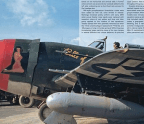
ON THE AIRFIELD at Barkston-Heath (USAAF Station AAF-483) near the city of Grantham in Lincolnshire, 72 Douglas C-47 Skytrain transports from the 61st Troop Carrier Group sat waiting. Soon they would carry 1,230 paratroopers from the 2nd and 3rd Battalions of the 507th Parachute Infantry Regiment to Normandy as a part of Mission Boston, the code name of the operation to move the 82nd Airborne Division to France on D-Day. Just seven miles away on the airfield at Fulbeck (USAAF Station AAF-488), 45 C-47s of the 442nd Troop Carrier Group were preparing to load the regimental headquarters and the 1st Battalion, 507th—an additional 770 paratroopers. By mid-1944, the flight crews of those two troop carrier groups had gone through just as much intense training as the paratroopers they would carry into battle.

First came training, then the trip, then more training
For the pilots, copilots, radio operators, navigators, and crew chiefs, their military service had begun as much as two years earlier with primary, and then advanced, training. They were by then intimately familiar with the venerable Douglas C-47 Skytrain, which the U.S. military relied on throughout the Second World War as one of its primary military movers. After earning their wings, the fresh aviators of the 61st and 442nd Troop Carrier Groups spent three or four additional months of training and familiarization with the C-47 learning the idiosyncrasies of its flight characteristics. That phase was inevitably followed by assignment to a troop carrier squadron and then deployment overseas.
Sidney M. Ulan of Chester, Pennsylvania, received his wings at Moody Field in March 1943 and, like so many other new Skytrain pilots, he was immediately assigned to the Troop Carrier Command. He recalled that, at the time, the Army needed pilots




